Asda Business Portfolio: Competitive Analysis and Strategic Adaptation
VerifiedAdded on 2020/07/22
|13
|2306
|42
Portfolio
AI Summary
This portfolio provides a comprehensive analysis of Asda Store Ltd, a British retailer. It begins with an examination of Asda's organizational structure, identifying its hierarchical and functional characteristics. The analysis then delves into Porter's Five Forces framework to assess the competitive intensity within the UK retail sector, considering factors like competitive rivalry, entry barriers, and the bargaining power of buyers and suppliers. The report further explores Asda's industry, workforce management practices, and the company's adaptation to changing consumer demands, including the shift towards online marketing and non-food product offerings. Finally, it discusses the entrepreneurial motivations of Asda's founder, J.W. Hindell, highlighting factors like creativity and risk-taking. The portfolio concludes by summarizing the key findings and insights regarding Asda's business strategies and its responses to market dynamics.

PORTFOLIO
Paraphrase This Document
Need a fresh take? Get an instant paraphrase of this document with our AI Paraphraser
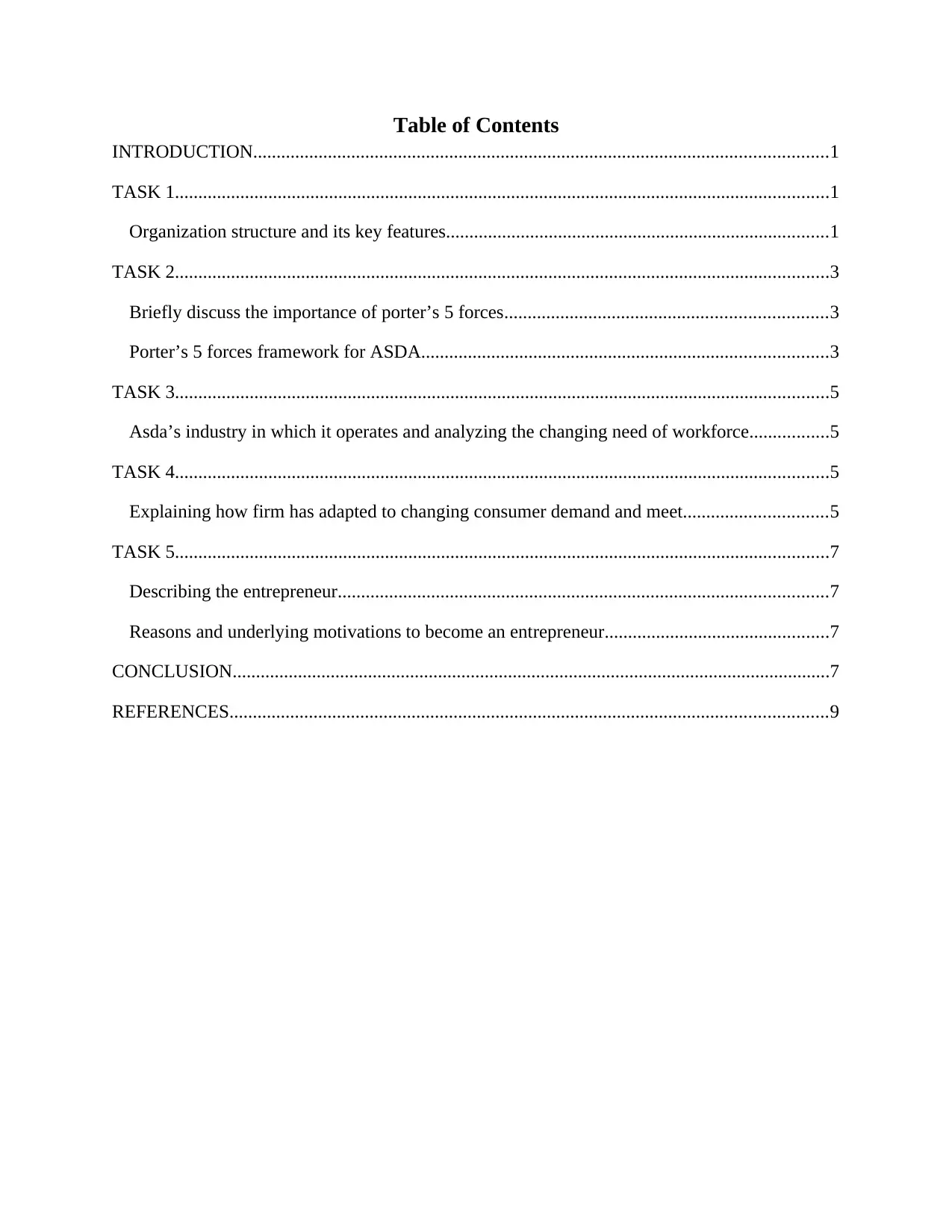
Table of Contents
INTRODUCTION...........................................................................................................................1
TASK 1............................................................................................................................................1
Organization structure and its key features..................................................................................1
TASK 2............................................................................................................................................3
Briefly discuss the importance of porter’s 5 forces.....................................................................3
Porter’s 5 forces framework for ASDA.......................................................................................3
TASK 3............................................................................................................................................5
Asda’s industry in which it operates and analyzing the changing need of workforce.................5
TASK 4............................................................................................................................................5
Explaining how firm has adapted to changing consumer demand and meet...............................5
TASK 5............................................................................................................................................7
Describing the entrepreneur.........................................................................................................7
Reasons and underlying motivations to become an entrepreneur................................................7
CONCLUSION................................................................................................................................7
REFERENCES................................................................................................................................9
INTRODUCTION...........................................................................................................................1
TASK 1............................................................................................................................................1
Organization structure and its key features..................................................................................1
TASK 2............................................................................................................................................3
Briefly discuss the importance of porter’s 5 forces.....................................................................3
Porter’s 5 forces framework for ASDA.......................................................................................3
TASK 3............................................................................................................................................5
Asda’s industry in which it operates and analyzing the changing need of workforce.................5
TASK 4............................................................................................................................................5
Explaining how firm has adapted to changing consumer demand and meet...............................5
TASK 5............................................................................................................................................7
Describing the entrepreneur.........................................................................................................7
Reasons and underlying motivations to become an entrepreneur................................................7
CONCLUSION................................................................................................................................7
REFERENCES................................................................................................................................9
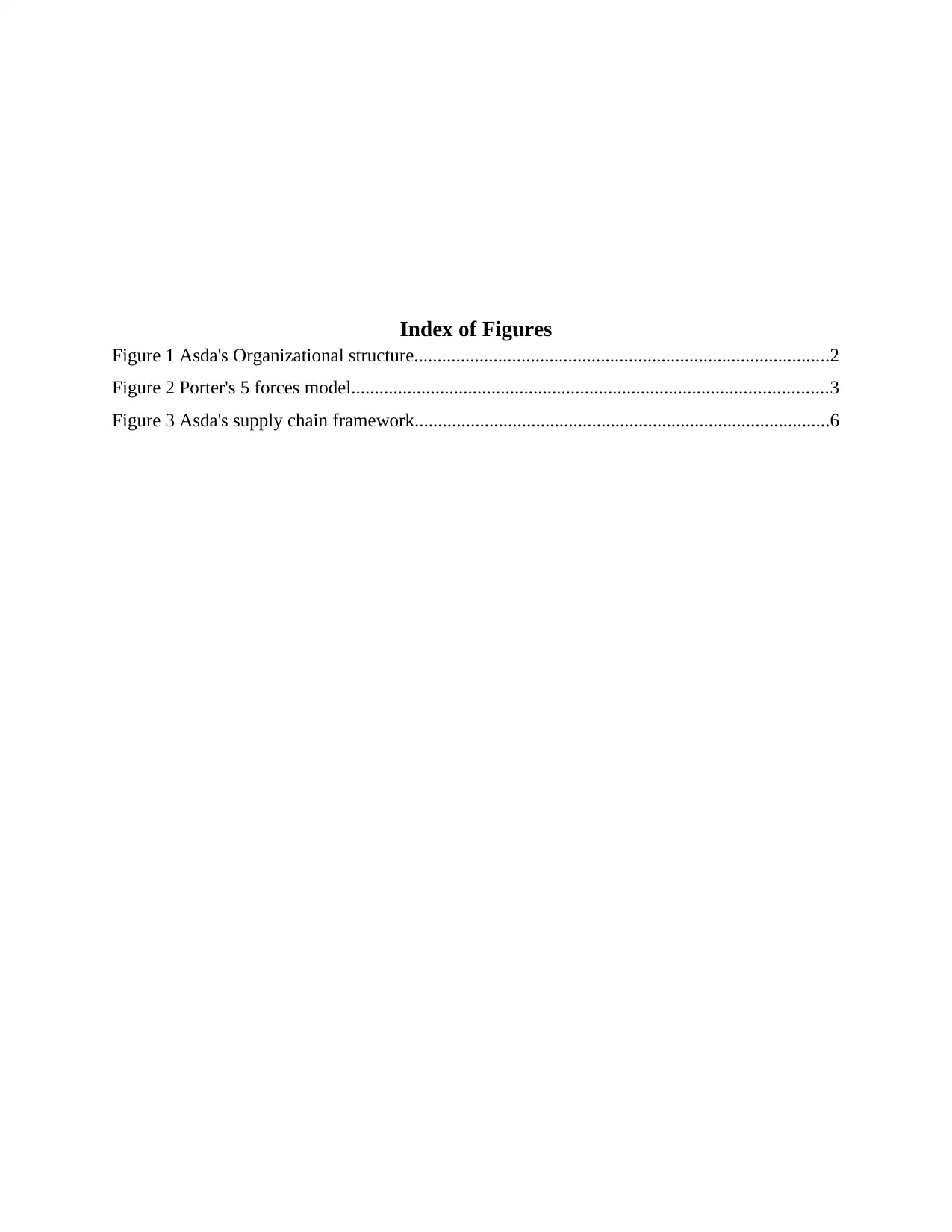
Index of Figures
Figure 1 Asda's Organizational structure.........................................................................................2
Figure 2 Porter's 5 forces model......................................................................................................3
Figure 3 Asda's supply chain framework.........................................................................................6
Figure 1 Asda's Organizational structure.........................................................................................2
Figure 2 Porter's 5 forces model......................................................................................................3
Figure 3 Asda's supply chain framework.........................................................................................6
⊘ This is a preview!⊘
Do you want full access?
Subscribe today to unlock all pages.

Trusted by 1+ million students worldwide
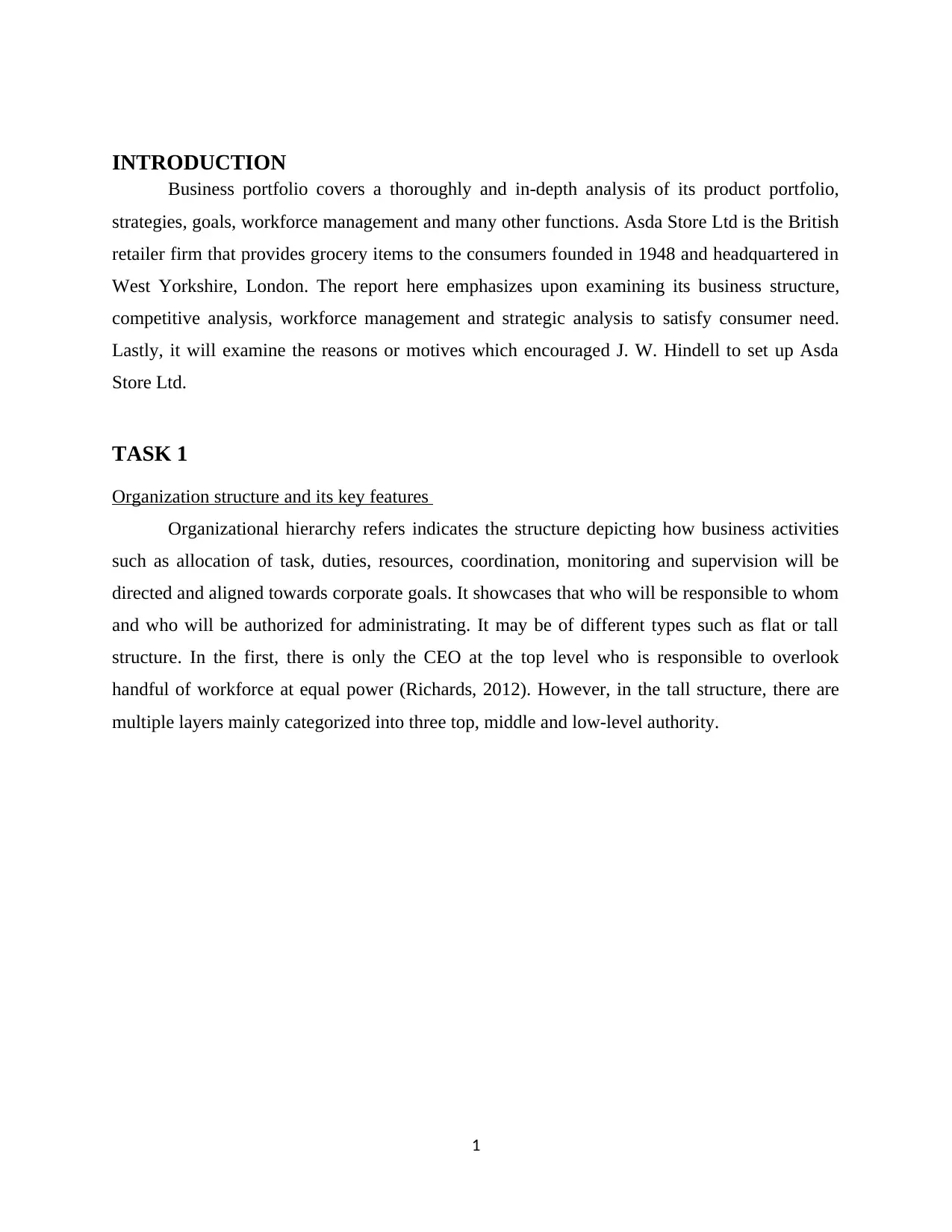
INTRODUCTION
Business portfolio covers a thoroughly and in-depth analysis of its product portfolio,
strategies, goals, workforce management and many other functions. Asda Store Ltd is the British
retailer firm that provides grocery items to the consumers founded in 1948 and headquartered in
West Yorkshire, London. The report here emphasizes upon examining its business structure,
competitive analysis, workforce management and strategic analysis to satisfy consumer need.
Lastly, it will examine the reasons or motives which encouraged J. W. Hindell to set up Asda
Store Ltd.
TASK 1
Organization structure and its key features
Organizational hierarchy refers indicates the structure depicting how business activities
such as allocation of task, duties, resources, coordination, monitoring and supervision will be
directed and aligned towards corporate goals. It showcases that who will be responsible to whom
and who will be authorized for administrating. It may be of different types such as flat or tall
structure. In the first, there is only the CEO at the top level who is responsible to overlook
handful of workforce at equal power (Richards, 2012). However, in the tall structure, there are
multiple layers mainly categorized into three top, middle and low-level authority.
1
Business portfolio covers a thoroughly and in-depth analysis of its product portfolio,
strategies, goals, workforce management and many other functions. Asda Store Ltd is the British
retailer firm that provides grocery items to the consumers founded in 1948 and headquartered in
West Yorkshire, London. The report here emphasizes upon examining its business structure,
competitive analysis, workforce management and strategic analysis to satisfy consumer need.
Lastly, it will examine the reasons or motives which encouraged J. W. Hindell to set up Asda
Store Ltd.
TASK 1
Organization structure and its key features
Organizational hierarchy refers indicates the structure depicting how business activities
such as allocation of task, duties, resources, coordination, monitoring and supervision will be
directed and aligned towards corporate goals. It showcases that who will be responsible to whom
and who will be authorized for administrating. It may be of different types such as flat or tall
structure. In the first, there is only the CEO at the top level who is responsible to overlook
handful of workforce at equal power (Richards, 2012). However, in the tall structure, there are
multiple layers mainly categorized into three top, middle and low-level authority.
1
Paraphrase This Document
Need a fresh take? Get an instant paraphrase of this document with our AI Paraphraser
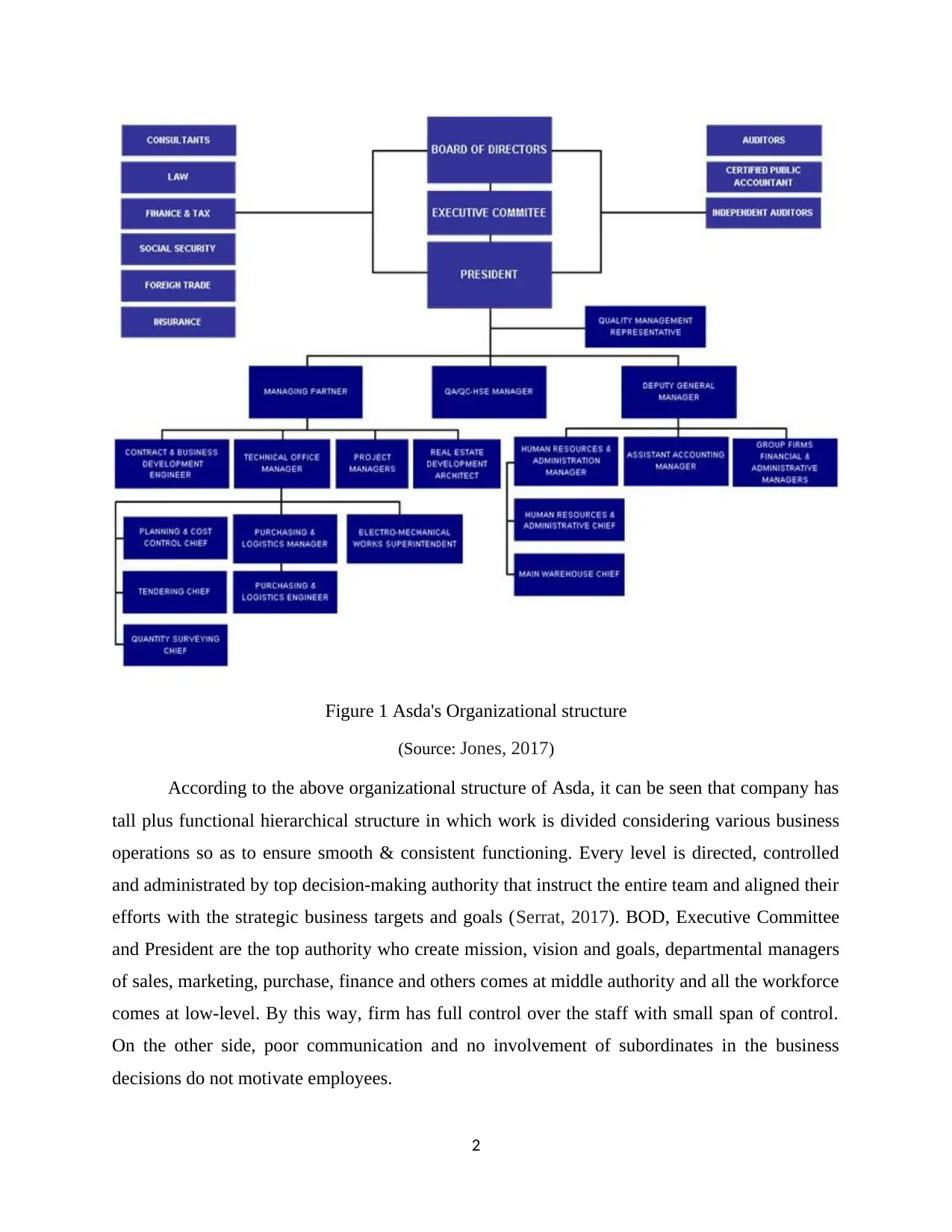
Figure 1 Asda's Organizational structure
(Source: Jones, 2017)
According to the above organizational structure of Asda, it can be seen that company has
tall plus functional hierarchical structure in which work is divided considering various business
operations so as to ensure smooth & consistent functioning. Every level is directed, controlled
and administrated by top decision-making authority that instruct the entire team and aligned their
efforts with the strategic business targets and goals (Serrat, 2017). BOD, Executive Committee
and President are the top authority who create mission, vision and goals, departmental managers
of sales, marketing, purchase, finance and others comes at middle authority and all the workforce
comes at low-level. By this way, firm has full control over the staff with small span of control.
On the other side, poor communication and no involvement of subordinates in the business
decisions do not motivate employees.
2
(Source: Jones, 2017)
According to the above organizational structure of Asda, it can be seen that company has
tall plus functional hierarchical structure in which work is divided considering various business
operations so as to ensure smooth & consistent functioning. Every level is directed, controlled
and administrated by top decision-making authority that instruct the entire team and aligned their
efforts with the strategic business targets and goals (Serrat, 2017). BOD, Executive Committee
and President are the top authority who create mission, vision and goals, departmental managers
of sales, marketing, purchase, finance and others comes at middle authority and all the workforce
comes at low-level. By this way, firm has full control over the staff with small span of control.
On the other side, poor communication and no involvement of subordinates in the business
decisions do not motivate employees.
2
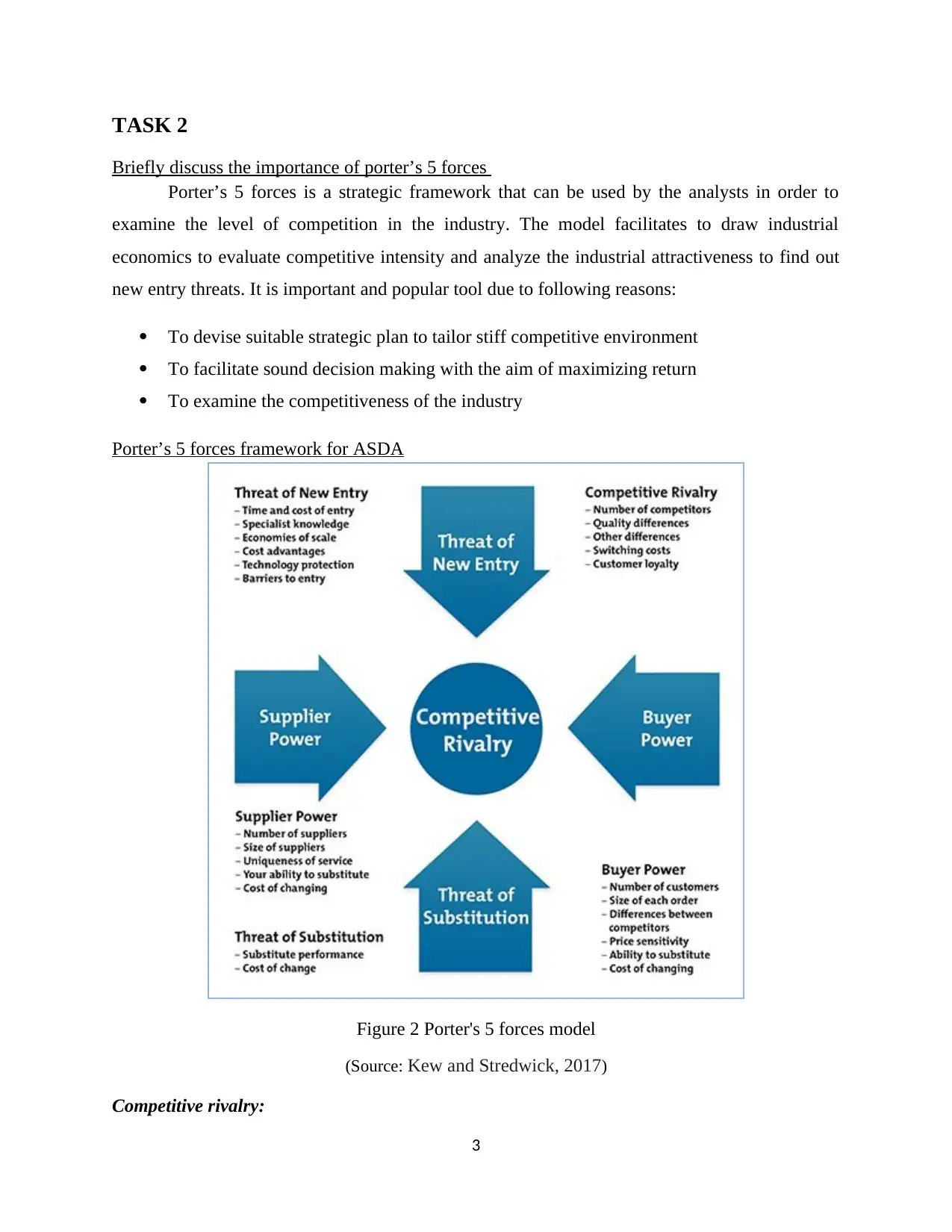
TASK 2
Briefly discuss the importance of porter’s 5 forces
Porter’s 5 forces is a strategic framework that can be used by the analysts in order to
examine the level of competition in the industry. The model facilitates to draw industrial
economics to evaluate competitive intensity and analyze the industrial attractiveness to find out
new entry threats. It is important and popular tool due to following reasons:
To devise suitable strategic plan to tailor stiff competitive environment
To facilitate sound decision making with the aim of maximizing return
To examine the competitiveness of the industry
Porter’s 5 forces framework for ASDA
Figure 2 Porter's 5 forces model
(Source: Kew and Stredwick, 2017)
Competitive rivalry:
3
Briefly discuss the importance of porter’s 5 forces
Porter’s 5 forces is a strategic framework that can be used by the analysts in order to
examine the level of competition in the industry. The model facilitates to draw industrial
economics to evaluate competitive intensity and analyze the industrial attractiveness to find out
new entry threats. It is important and popular tool due to following reasons:
To devise suitable strategic plan to tailor stiff competitive environment
To facilitate sound decision making with the aim of maximizing return
To examine the competitiveness of the industry
Porter’s 5 forces framework for ASDA
Figure 2 Porter's 5 forces model
(Source: Kew and Stredwick, 2017)
Competitive rivalry:
3
⊘ This is a preview!⊘
Do you want full access?
Subscribe today to unlock all pages.

Trusted by 1+ million students worldwide
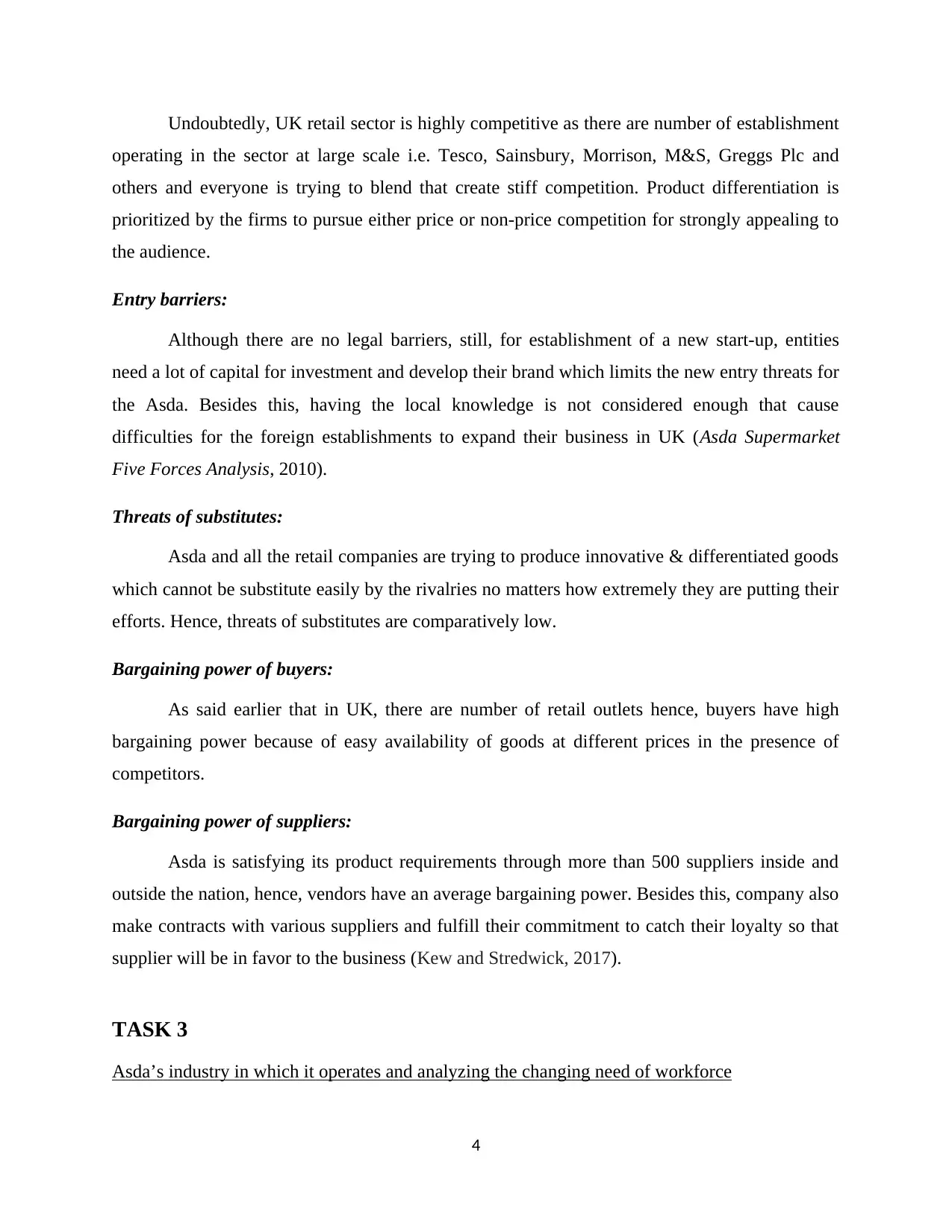
Undoubtedly, UK retail sector is highly competitive as there are number of establishment
operating in the sector at large scale i.e. Tesco, Sainsbury, Morrison, M&S, Greggs Plc and
others and everyone is trying to blend that create stiff competition. Product differentiation is
prioritized by the firms to pursue either price or non-price competition for strongly appealing to
the audience.
Entry barriers:
Although there are no legal barriers, still, for establishment of a new start-up, entities
need a lot of capital for investment and develop their brand which limits the new entry threats for
the Asda. Besides this, having the local knowledge is not considered enough that cause
difficulties for the foreign establishments to expand their business in UK (Asda Supermarket
Five Forces Analysis, 2010).
Threats of substitutes:
Asda and all the retail companies are trying to produce innovative & differentiated goods
which cannot be substitute easily by the rivalries no matters how extremely they are putting their
efforts. Hence, threats of substitutes are comparatively low.
Bargaining power of buyers:
As said earlier that in UK, there are number of retail outlets hence, buyers have high
bargaining power because of easy availability of goods at different prices in the presence of
competitors.
Bargaining power of suppliers:
Asda is satisfying its product requirements through more than 500 suppliers inside and
outside the nation, hence, vendors have an average bargaining power. Besides this, company also
make contracts with various suppliers and fulfill their commitment to catch their loyalty so that
supplier will be in favor to the business (Kew and Stredwick, 2017).
TASK 3
Asda’s industry in which it operates and analyzing the changing need of workforce
4
operating in the sector at large scale i.e. Tesco, Sainsbury, Morrison, M&S, Greggs Plc and
others and everyone is trying to blend that create stiff competition. Product differentiation is
prioritized by the firms to pursue either price or non-price competition for strongly appealing to
the audience.
Entry barriers:
Although there are no legal barriers, still, for establishment of a new start-up, entities
need a lot of capital for investment and develop their brand which limits the new entry threats for
the Asda. Besides this, having the local knowledge is not considered enough that cause
difficulties for the foreign establishments to expand their business in UK (Asda Supermarket
Five Forces Analysis, 2010).
Threats of substitutes:
Asda and all the retail companies are trying to produce innovative & differentiated goods
which cannot be substitute easily by the rivalries no matters how extremely they are putting their
efforts. Hence, threats of substitutes are comparatively low.
Bargaining power of buyers:
As said earlier that in UK, there are number of retail outlets hence, buyers have high
bargaining power because of easy availability of goods at different prices in the presence of
competitors.
Bargaining power of suppliers:
Asda is satisfying its product requirements through more than 500 suppliers inside and
outside the nation, hence, vendors have an average bargaining power. Besides this, company also
make contracts with various suppliers and fulfill their commitment to catch their loyalty so that
supplier will be in favor to the business (Kew and Stredwick, 2017).
TASK 3
Asda’s industry in which it operates and analyzing the changing need of workforce
4
Paraphrase This Document
Need a fresh take? Get an instant paraphrase of this document with our AI Paraphraser
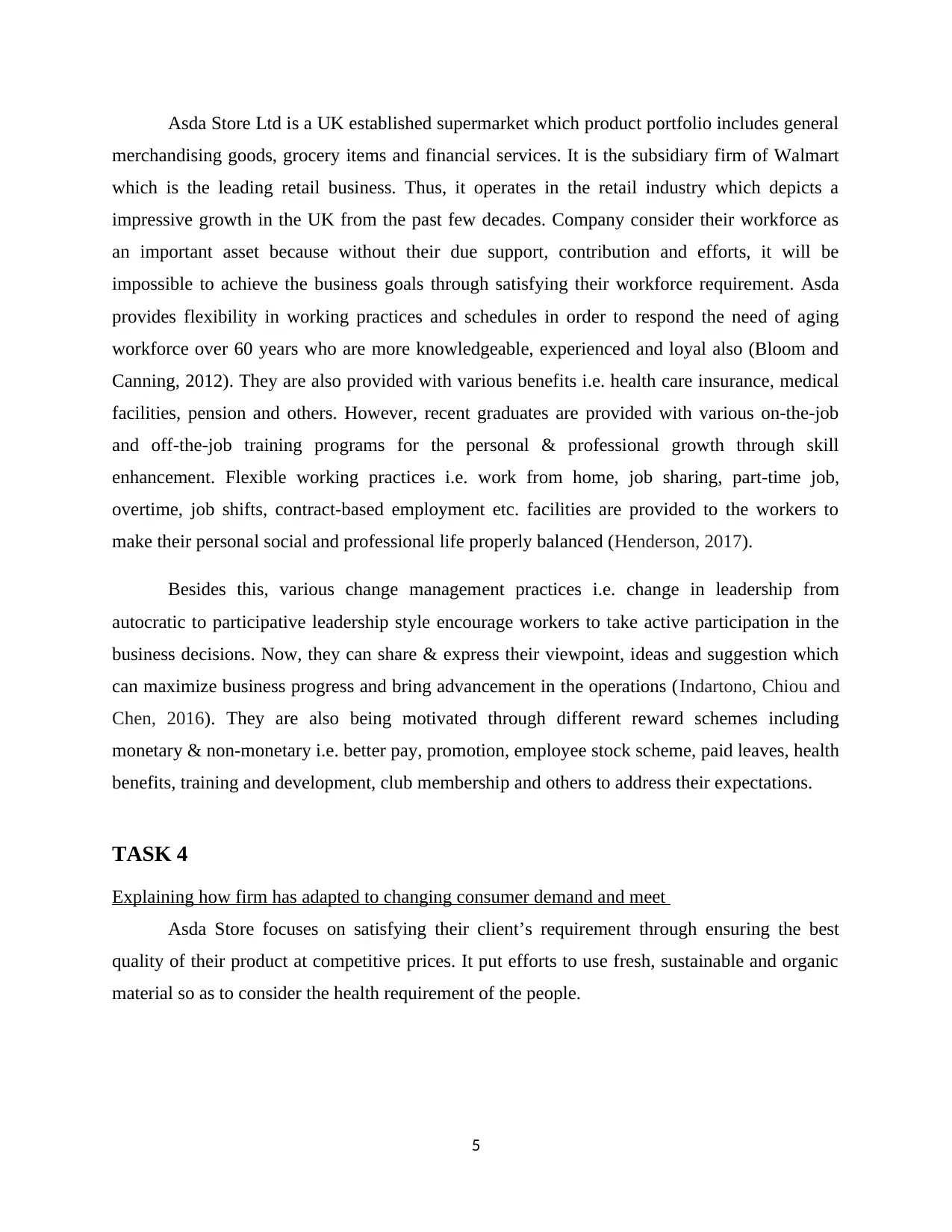
Asda Store Ltd is a UK established supermarket which product portfolio includes general
merchandising goods, grocery items and financial services. It is the subsidiary firm of Walmart
which is the leading retail business. Thus, it operates in the retail industry which depicts a
impressive growth in the UK from the past few decades. Company consider their workforce as
an important asset because without their due support, contribution and efforts, it will be
impossible to achieve the business goals through satisfying their workforce requirement. Asda
provides flexibility in working practices and schedules in order to respond the need of aging
workforce over 60 years who are more knowledgeable, experienced and loyal also (Bloom and
Canning, 2012). They are also provided with various benefits i.e. health care insurance, medical
facilities, pension and others. However, recent graduates are provided with various on-the-job
and off-the-job training programs for the personal & professional growth through skill
enhancement. Flexible working practices i.e. work from home, job sharing, part-time job,
overtime, job shifts, contract-based employment etc. facilities are provided to the workers to
make their personal social and professional life properly balanced (Henderson, 2017).
Besides this, various change management practices i.e. change in leadership from
autocratic to participative leadership style encourage workers to take active participation in the
business decisions. Now, they can share & express their viewpoint, ideas and suggestion which
can maximize business progress and bring advancement in the operations (Indartono, Chiou and
Chen, 2016). They are also being motivated through different reward schemes including
monetary & non-monetary i.e. better pay, promotion, employee stock scheme, paid leaves, health
benefits, training and development, club membership and others to address their expectations.
TASK 4
Explaining how firm has adapted to changing consumer demand and meet
Asda Store focuses on satisfying their client’s requirement through ensuring the best
quality of their product at competitive prices. It put efforts to use fresh, sustainable and organic
material so as to consider the health requirement of the people.
5
merchandising goods, grocery items and financial services. It is the subsidiary firm of Walmart
which is the leading retail business. Thus, it operates in the retail industry which depicts a
impressive growth in the UK from the past few decades. Company consider their workforce as
an important asset because without their due support, contribution and efforts, it will be
impossible to achieve the business goals through satisfying their workforce requirement. Asda
provides flexibility in working practices and schedules in order to respond the need of aging
workforce over 60 years who are more knowledgeable, experienced and loyal also (Bloom and
Canning, 2012). They are also provided with various benefits i.e. health care insurance, medical
facilities, pension and others. However, recent graduates are provided with various on-the-job
and off-the-job training programs for the personal & professional growth through skill
enhancement. Flexible working practices i.e. work from home, job sharing, part-time job,
overtime, job shifts, contract-based employment etc. facilities are provided to the workers to
make their personal social and professional life properly balanced (Henderson, 2017).
Besides this, various change management practices i.e. change in leadership from
autocratic to participative leadership style encourage workers to take active participation in the
business decisions. Now, they can share & express their viewpoint, ideas and suggestion which
can maximize business progress and bring advancement in the operations (Indartono, Chiou and
Chen, 2016). They are also being motivated through different reward schemes including
monetary & non-monetary i.e. better pay, promotion, employee stock scheme, paid leaves, health
benefits, training and development, club membership and others to address their expectations.
TASK 4
Explaining how firm has adapted to changing consumer demand and meet
Asda Store focuses on satisfying their client’s requirement through ensuring the best
quality of their product at competitive prices. It put efforts to use fresh, sustainable and organic
material so as to consider the health requirement of the people.
5
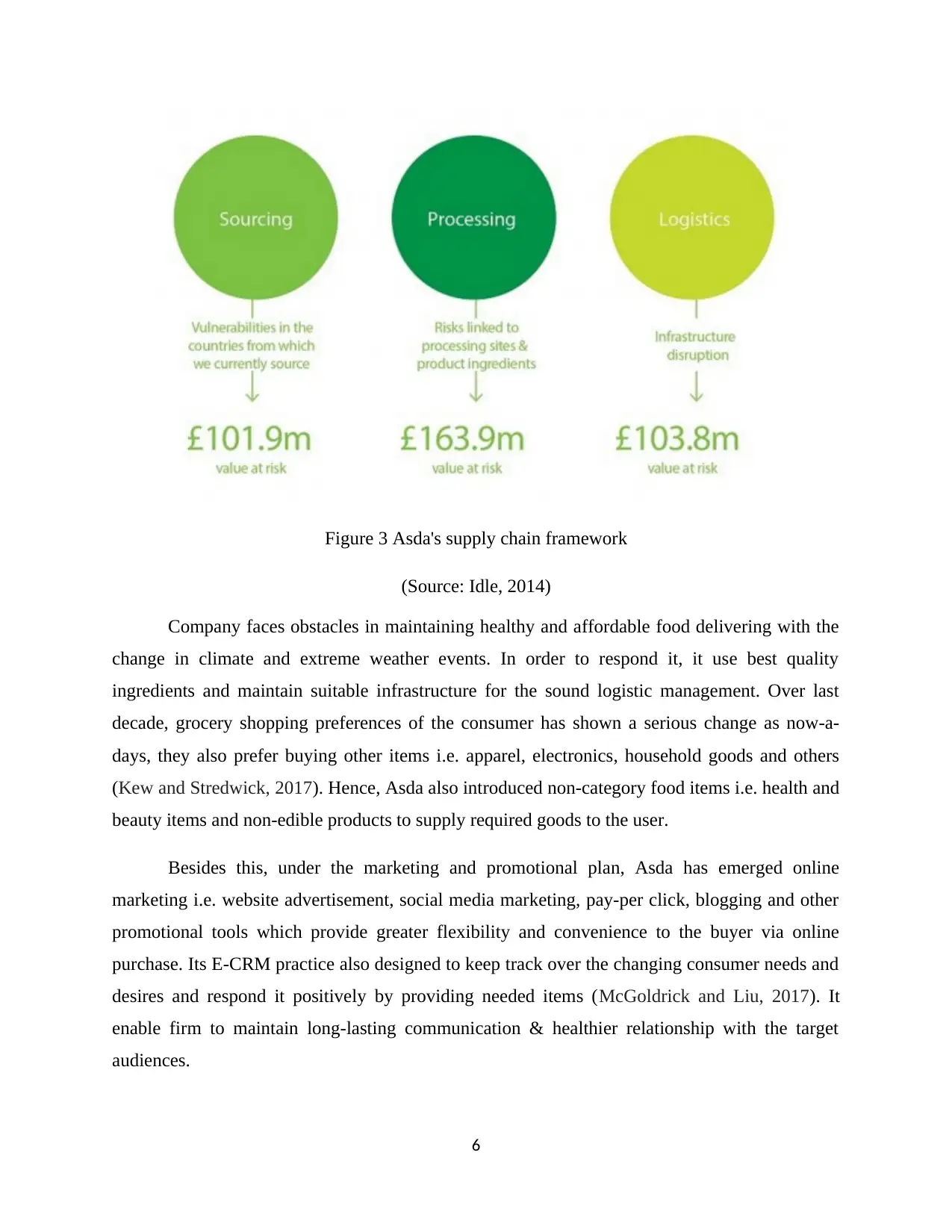
Figure 3 Asda's supply chain framework
(Source: Idle, 2014)
Company faces obstacles in maintaining healthy and affordable food delivering with the
change in climate and extreme weather events. In order to respond it, it use best quality
ingredients and maintain suitable infrastructure for the sound logistic management. Over last
decade, grocery shopping preferences of the consumer has shown a serious change as now-a-
days, they also prefer buying other items i.e. apparel, electronics, household goods and others
(Kew and Stredwick, 2017). Hence, Asda also introduced non-category food items i.e. health and
beauty items and non-edible products to supply required goods to the user.
Besides this, under the marketing and promotional plan, Asda has emerged online
marketing i.e. website advertisement, social media marketing, pay-per click, blogging and other
promotional tools which provide greater flexibility and convenience to the buyer via online
purchase. Its E-CRM practice also designed to keep track over the changing consumer needs and
desires and respond it positively by providing needed items (McGoldrick and Liu, 2017). It
enable firm to maintain long-lasting communication & healthier relationship with the target
audiences.
6
(Source: Idle, 2014)
Company faces obstacles in maintaining healthy and affordable food delivering with the
change in climate and extreme weather events. In order to respond it, it use best quality
ingredients and maintain suitable infrastructure for the sound logistic management. Over last
decade, grocery shopping preferences of the consumer has shown a serious change as now-a-
days, they also prefer buying other items i.e. apparel, electronics, household goods and others
(Kew and Stredwick, 2017). Hence, Asda also introduced non-category food items i.e. health and
beauty items and non-edible products to supply required goods to the user.
Besides this, under the marketing and promotional plan, Asda has emerged online
marketing i.e. website advertisement, social media marketing, pay-per click, blogging and other
promotional tools which provide greater flexibility and convenience to the buyer via online
purchase. Its E-CRM practice also designed to keep track over the changing consumer needs and
desires and respond it positively by providing needed items (McGoldrick and Liu, 2017). It
enable firm to maintain long-lasting communication & healthier relationship with the target
audiences.
6
⊘ This is a preview!⊘
Do you want full access?
Subscribe today to unlock all pages.

Trusted by 1+ million students worldwide
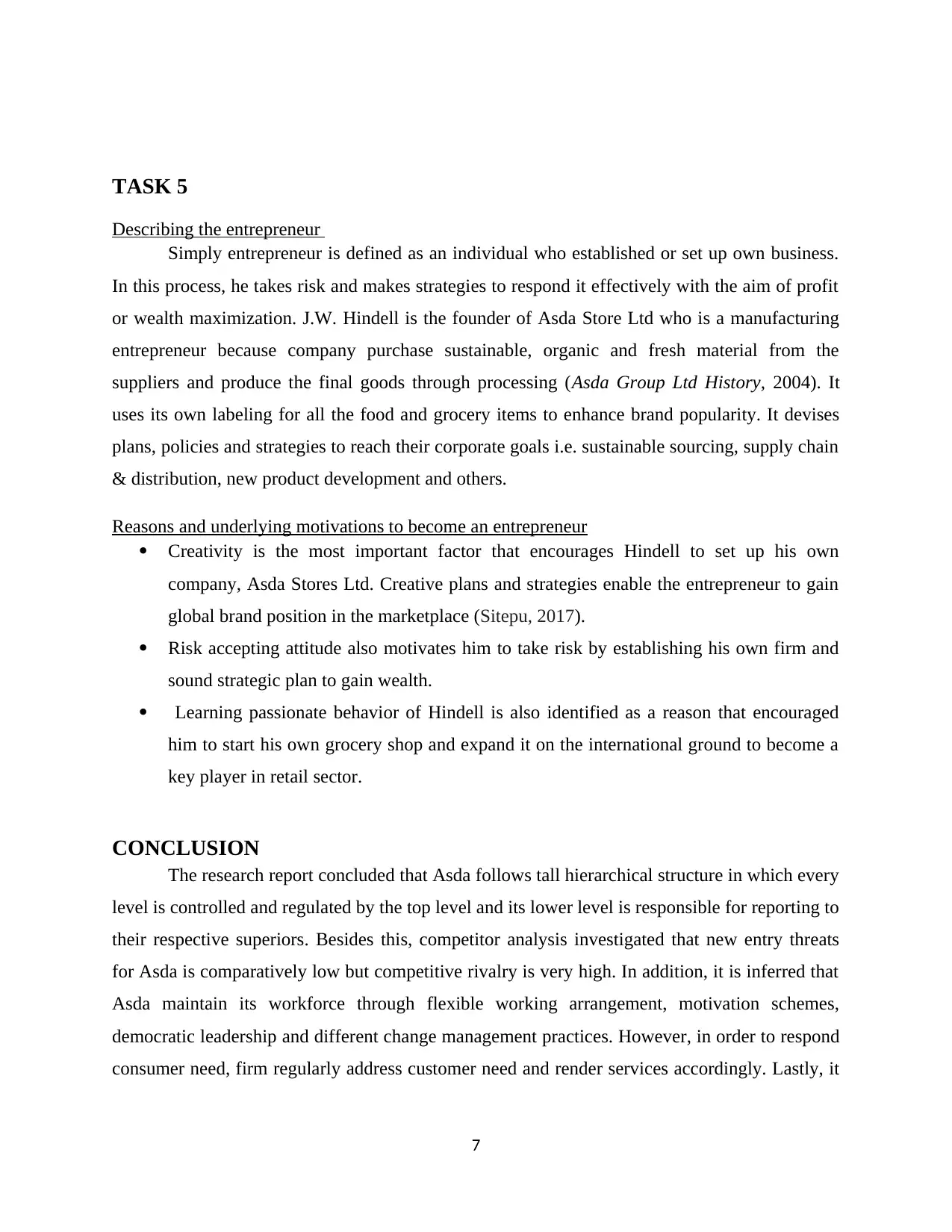
TASK 5
Describing the entrepreneur
Simply entrepreneur is defined as an individual who established or set up own business.
In this process, he takes risk and makes strategies to respond it effectively with the aim of profit
or wealth maximization. J.W. Hindell is the founder of Asda Store Ltd who is a manufacturing
entrepreneur because company purchase sustainable, organic and fresh material from the
suppliers and produce the final goods through processing (Asda Group Ltd History, 2004). It
uses its own labeling for all the food and grocery items to enhance brand popularity. It devises
plans, policies and strategies to reach their corporate goals i.e. sustainable sourcing, supply chain
& distribution, new product development and others.
Reasons and underlying motivations to become an entrepreneur
Creativity is the most important factor that encourages Hindell to set up his own
company, Asda Stores Ltd. Creative plans and strategies enable the entrepreneur to gain
global brand position in the marketplace (Sitepu, 2017).
Risk accepting attitude also motivates him to take risk by establishing his own firm and
sound strategic plan to gain wealth.
Learning passionate behavior of Hindell is also identified as a reason that encouraged
him to start his own grocery shop and expand it on the international ground to become a
key player in retail sector.
CONCLUSION
The research report concluded that Asda follows tall hierarchical structure in which every
level is controlled and regulated by the top level and its lower level is responsible for reporting to
their respective superiors. Besides this, competitor analysis investigated that new entry threats
for Asda is comparatively low but competitive rivalry is very high. In addition, it is inferred that
Asda maintain its workforce through flexible working arrangement, motivation schemes,
democratic leadership and different change management practices. However, in order to respond
consumer need, firm regularly address customer need and render services accordingly. Lastly, it
7
Describing the entrepreneur
Simply entrepreneur is defined as an individual who established or set up own business.
In this process, he takes risk and makes strategies to respond it effectively with the aim of profit
or wealth maximization. J.W. Hindell is the founder of Asda Store Ltd who is a manufacturing
entrepreneur because company purchase sustainable, organic and fresh material from the
suppliers and produce the final goods through processing (Asda Group Ltd History, 2004). It
uses its own labeling for all the food and grocery items to enhance brand popularity. It devises
plans, policies and strategies to reach their corporate goals i.e. sustainable sourcing, supply chain
& distribution, new product development and others.
Reasons and underlying motivations to become an entrepreneur
Creativity is the most important factor that encourages Hindell to set up his own
company, Asda Stores Ltd. Creative plans and strategies enable the entrepreneur to gain
global brand position in the marketplace (Sitepu, 2017).
Risk accepting attitude also motivates him to take risk by establishing his own firm and
sound strategic plan to gain wealth.
Learning passionate behavior of Hindell is also identified as a reason that encouraged
him to start his own grocery shop and expand it on the international ground to become a
key player in retail sector.
CONCLUSION
The research report concluded that Asda follows tall hierarchical structure in which every
level is controlled and regulated by the top level and its lower level is responsible for reporting to
their respective superiors. Besides this, competitor analysis investigated that new entry threats
for Asda is comparatively low but competitive rivalry is very high. In addition, it is inferred that
Asda maintain its workforce through flexible working arrangement, motivation schemes,
democratic leadership and different change management practices. However, in order to respond
consumer need, firm regularly address customer need and render services accordingly. Lastly, it
7
Paraphrase This Document
Need a fresh take? Get an instant paraphrase of this document with our AI Paraphraser

is founded that creativity, innovation, risk accepting attitude & passionate learning behavior
factors encourage Hindell to establish Asda Store Ltd.
8
factors encourage Hindell to establish Asda Store Ltd.
8
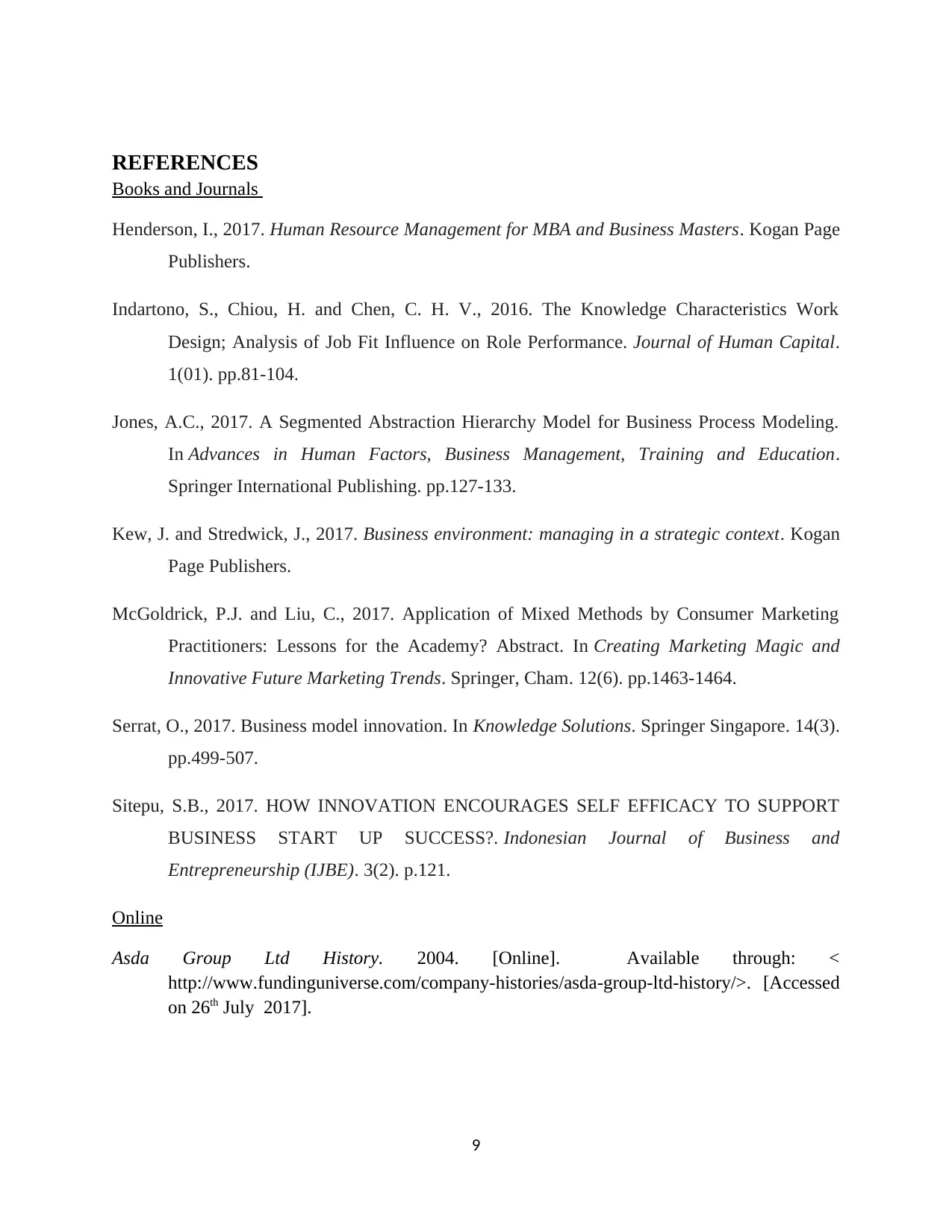
REFERENCES
Books and Journals
Henderson, I., 2017. Human Resource Management for MBA and Business Masters. Kogan Page
Publishers.
Indartono, S., Chiou, H. and Chen, C. H. V., 2016. The Knowledge Characteristics Work
Design; Analysis of Job Fit Influence on Role Performance. Journal of Human Capital.
1(01). pp.81-104.
Jones, A.C., 2017. A Segmented Abstraction Hierarchy Model for Business Process Modeling.
In Advances in Human Factors, Business Management, Training and Education.
Springer International Publishing. pp.127-133.
Kew, J. and Stredwick, J., 2017. Business environment: managing in a strategic context. Kogan
Page Publishers.
McGoldrick, P.J. and Liu, C., 2017. Application of Mixed Methods by Consumer Marketing
Practitioners: Lessons for the Academy? Abstract. In Creating Marketing Magic and
Innovative Future Marketing Trends. Springer, Cham. 12(6). pp.1463-1464.
Serrat, O., 2017. Business model innovation. In Knowledge Solutions. Springer Singapore. 14(3).
pp.499-507.
Sitepu, S.B., 2017. HOW INNOVATION ENCOURAGES SELF EFFICACY TO SUPPORT
BUSINESS START UP SUCCESS?. Indonesian Journal of Business and
Entrepreneurship (IJBE). 3(2). p.121.
Online
Asda Group Ltd History. 2004. [Online]. Available through: <
http://www.fundinguniverse.com/company-histories/asda-group-ltd-history/>. [Accessed
on 26th July 2017].
9
Books and Journals
Henderson, I., 2017. Human Resource Management for MBA and Business Masters. Kogan Page
Publishers.
Indartono, S., Chiou, H. and Chen, C. H. V., 2016. The Knowledge Characteristics Work
Design; Analysis of Job Fit Influence on Role Performance. Journal of Human Capital.
1(01). pp.81-104.
Jones, A.C., 2017. A Segmented Abstraction Hierarchy Model for Business Process Modeling.
In Advances in Human Factors, Business Management, Training and Education.
Springer International Publishing. pp.127-133.
Kew, J. and Stredwick, J., 2017. Business environment: managing in a strategic context. Kogan
Page Publishers.
McGoldrick, P.J. and Liu, C., 2017. Application of Mixed Methods by Consumer Marketing
Practitioners: Lessons for the Academy? Abstract. In Creating Marketing Magic and
Innovative Future Marketing Trends. Springer, Cham. 12(6). pp.1463-1464.
Serrat, O., 2017. Business model innovation. In Knowledge Solutions. Springer Singapore. 14(3).
pp.499-507.
Sitepu, S.B., 2017. HOW INNOVATION ENCOURAGES SELF EFFICACY TO SUPPORT
BUSINESS START UP SUCCESS?. Indonesian Journal of Business and
Entrepreneurship (IJBE). 3(2). p.121.
Online
Asda Group Ltd History. 2004. [Online]. Available through: <
http://www.fundinguniverse.com/company-histories/asda-group-ltd-history/>. [Accessed
on 26th July 2017].
9
⊘ This is a preview!⊘
Do you want full access?
Subscribe today to unlock all pages.

Trusted by 1+ million students worldwide
1 out of 13
Related Documents
Your All-in-One AI-Powered Toolkit for Academic Success.
+13062052269
info@desklib.com
Available 24*7 on WhatsApp / Email
![[object Object]](/_next/static/media/star-bottom.7253800d.svg)
Unlock your academic potential
Copyright © 2020–2025 A2Z Services. All Rights Reserved. Developed and managed by ZUCOL.



